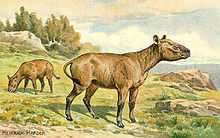Hyracodontidae
| Hyracodontidae[1] Temporal range: Early Eocene–Early Miocene | |
|---|---|
 | |
| Hyracodon | |
| Scientific classification | |
| Kingdom: | Animalia |
| Phylum: | Chordata |
| Class: | Mammalia |
| Order: | Perissodactyla |
| Superfamily: | Rhinocerotoidea |
| Family: | †Hyracodontidae Cope, 1879 |
| Subfamilies | |
| |
Hyracodontidae is an extinct family of rhinoceroses endemic to North America, Europe, and Asia during the Eocene through early Miocene living from 55.8—20 mya, existing for approximately 35.8 million years.[2]
They are typified as having long limbs and having no horns. These animals were initially modest in size and fast moving, having evolved from smaller members of Rhinocerotoidea during the Late Eocene and Early Oligocene. They later evolved into gigantic forms that included the largest terrestrial mammals ever to have lived (the Indricotheriinae or Paraceratheriinae).
Hyracodonotidae thrived in the rainforests of Kazakhstan, Pakistan, and southwest China, a former coastal region.
References
- ↑ McKenna, M. C, and S. K. Bell (1997). Classification of Mammals Above the Species Level. Columbia University Press. ISBN 0-231-11012-X.
- ↑ PaleoBiology Database: Hyracodontidae, basic info
- Lucas, S. G. & Sobus, J. C., (1989), The Systematics of Indricotheres. 358-378 in Prothero, D. R. & Schoch, R. M., (eds.) 1989: The Evolution of Perissodactyls, Oxford University Press, New York, New York & Oxford, England.